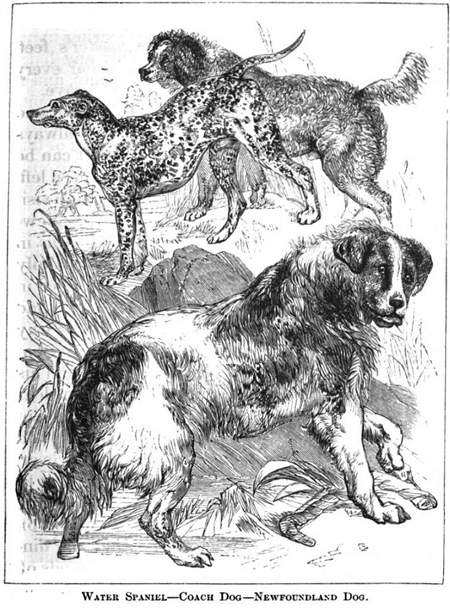We begin with that noble animal, the NewfoundLand Dog. This fine animal was brought at first from Newfoundland. In that island it is taught to draw sledges and carriages. It is a most faithful creature. It is very fond of water, and many are the cases in which it has saved the lives of those who but for its timely aid would have been drowned. One day a vessel was driven on the coast of Kent. It contained eight men, who cried piteously for help. The sea was so rough that no boat could put off to their assistance. At length a gentleman with his Newfoundland Dog came on the beach. He directed the attention of the animal to the vessel, and put a short stick in his mouth. The Dog at once saw what his master meant. He sprang into the sea, and fought his way through the waves. He could not, however, get close enough to the vessel to deliver the piece of wood, but when the crew threw him a piece of wood with a rope tied to it, he dropped his own and seized that which had been thrown to him, dragged it through the waves, and at length laid it at his master's feet. A means of rescue was thus formed, and every man on board was saved from a watery grave.
There are few Dogs which are able to fetch and carry better than the Newfoundland Dog. It always likes to have some article in its mouth. It can be trained to fetch any object that may have been left, even at a great distance. A gentleman was on a visit to a friend, and had taken with him a fine Newfoundland Dog. Being fond of reading, he was in the habit of taking his book with him in his daily walks. On one occasion he had been so absorbed in his book that he had staid far longer than he had intended; so, hastily pocketing it, he made his way home as quickly as possible. Just as he arrived at the house, he found that he had left behind him his gold-headed cane, which, being the gift of a dear friend, he valued very much. He would have sent his Dog to look for it, but it happened that he had gone out with some one else for a walk. However, as soon as the Dog arrived, he explained his loss to the animal, and desired him to fetch the missing cane. The Dog ran off" to obey the command of his master. While they were in the middle of dinner, a great uproar was heard in the hall—sounds of pushing and shuffling, and angry voices. Presently in rushed the Newfoundland Dog, bearing in his mouth the cane. He would not allow any hand but his master's to take it from his mouth, and it was his resistance to the attempts of the servants to do so that caused the commotion in the hall.

We give another instance of the sagacity of this noble animal. A gentleman, accompanied by his Newfoundland Dog, was riding with a friend one day, when the Dog became the subject of conversation. Having praised the qualities of his favorite very highly, the owner assured his companion that he would, upon receiving the order, return and fetch any article he should leave behind, from any distance. To confirm this, a marked shilling was put under a large square stone by the side of the road, being first shown to the Dog. The gentlemen then rode for three miles, when the Dog received his signal from the master to return for the shilling he had seen put under the stone. The Dog turned back, the gentlemen rode on, and reached home; but, to their surprise and disappointment, the hitherto faithful messenger did not return during the day. It afterward appeared that he had gone to the place where the shilling was placed, but the stone being too large for his strength to remove, he had staid howling at the place till two horsemen, riding by, and attracted by his seeming distress, stopped to look at him, when one of them, alighting, removed the stone, and, seeing the shilling, put it into his pocket, not at the time conceiving it to be the object of the Dog's search. The Dog followed their Horses for twenty miles, remained undisturbed in the room where they supped, followed the chambermaid into the bedchamber, and hid himself under one of the beds. The possessor of the shilling hung his trowsers upon a nail by the bedside ; but when the travelers were both asleep, the Dog took them in his mouth, and leaping out of the window, which was left open on account of the heat, reached the house of his master at four o'clock in the morning with the prize he had made free with, in the pocket of which were found a watch and money, that were returned upon being advertised, when the whole mystery was explained, to the admiration of all the parties.
The Esquimaux Dog is very useful to his master in drawing sledges and carrying heavy loads. It is rather smaller than the Newfoundland Dog. . . .